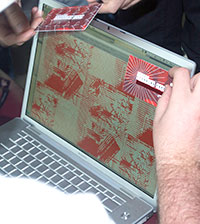© Keetra Dean Dixon & JK Keller
Snippets from workshops and curriculum
In an effort to “share the conversation” we keep one foot in academia via workshops and lectures. From 2010–2012 Keetra taught as a full-time professor in the Graphic Design department at the Maryland Institute College of Arts. During her time at MICA she developed a curriculum for upper-level undergraduates and MFA students that encourages the integration of exploratory methods and self-assessment into the design process.
The following asks how we can: stimulate our own curiosity, stimulate a sense of play, foster intuition, encourage diversity of concept & form, take risks, enable adaptation, allow for failure, and maintain momentum in our design process?
Curricular Goals:
– Develop comfort/willingness to pursue the unknown.
– Integrate research and development into the design process.
– Explore nontraditional form making & innovative tool use.
– Gain exposure to variations of brainstorming & ideation methods.
– Develop transparency of process.
– Practice interdisciplinary thinking.
– Explore the structuring of conditions and social exchange as design methodologies.
Excerpts from ProcessLAB Course Curriculum:
FORM (MISUSED & ABUSED)
CONCEPT (FRUSTRATE, IMPEDE, EVOLVE)
CONDITIONS (PROCESS AS PRODUCT)
INDIVIDUAL PROCESS (SELF HELP)
______________________________________________________________________________
ProcessLAB Project: FORM (MISUSED & ABUSED)
OVERVIEW: Designers each worked with an unusual material (wax, fat, fruit, sugar) as the source of experiments with form and image. They misused digital tools (slice, merge, filter, and so on) to derive unexpected results from familiar methods. The project culminated in the design of a “gift” presented to a fellow designer from whom they had surreptitiously stolen something from earlier in the project. – summarized by Ellen Lupton
RELATED ARTICLE: micadesign.org/2011/01/misused-and-abused/
RESULTING STUDIES:
Christine Brown
Assigned Material Misuse: Marshmallows
Assigned Digital Misuse Directive: Lock
Cameron Zotter
Assigned Material Misuse: Wax
Assigned Digital Misuse Directive: Dissect
EXCERPTS

______________________________________________________________________________
ProcessLAB Project: CONCEPT (FRUSTRATE, IMPEDE, EVOLVE)
OVERVIEW: Designers where asked to create a fictitious product in response to a chosen frustration. Over a three week period their plans where continually usurped by peer obstructions, reviews with restricted dialogue, speed challenges and brainstorming drills. New product concepts resulted from each step.
RESULTING WORK:
Allison Kerst
Frustration: Limited quality time with friends.
Final Product Concept: Heart 2 Heart; audio gem featuring Mariah Carey ballad. Designed for two users, each user holds a heart segment. While segments are united, audio plays properly. As heart segments are separated, song speed decreases with distance. Retractable chain pulls the segments back together.

Clara Kohn
Frustration: Actions and activities that make people feel excluded.
Sketch Concept: Multi-user Straw
Final Product Concept: Conversation Starter T-shirt


Ben Sifel
Frustration: excessive PDA: Public Display of Affection.
Final Product Concept: Magnetic clothes
Download full process pdf, 45.4MB

______________________________________________________________________________
ProcessLAB Project: CONDITIONS (PROCESS AS PRODUCT)
CONDITIONAL DESIGN: a process centric design approach popularized by a small group of Dutch designers in which the designer creates a set of restrictions, limitations or modified circumstances to be used by someone else. Use of conditions results in final artifact. Contemporary related terms and practices: Co-Creation, Participatory Design, Experiential Design, Generative Design.
OVERVIEW: Designers were asked to create a set of conditions consisting of rules, space structuring, templates, tools, and/or a kits of parts. Use of the conditions resulted in a 2D design/s that paid homage to an existing creative work.
RESULTING WORK:
Allison Kerst
Inspirational Creative Work: The work of Takeshi Murata
Final Conditions: Analog//GlitchDownload full process pdf, 27.8MB


Aura Seltzer
Inspirational Creative Work: “All The News That Fits”, Paula Scher, 2004
Final Conditions: “Fit All That”


Nicki Dlugash
Inspirational Creative Work: Model 8 of 2004 Syfy TV series Battlestar Galactica
Additional Influence: The Big Five factors: a psychological trait theory describing five broad dimensions of human personality: Openness to experience, Conscientiousness, Extraversion, Agreeableness, Neuroticism
Final Conditions: Program written with Processing.
Each final design is influenced by three factors: the pre-determined code, the additional code written by the participant, and the participant’s instantaneous decisions in the drawing process.Download full process pdf, 2.9MB


EXCERPTS



______________________________________________________________________________
ProcessLAB Project: INDIVIDUAL PROCESS (SELF HELP)
OVERVIEW: As a closing to the semester long course, Process LAB, designers where asked to evaluate their design process, identifying strengths, weaknesses and habits. They then construct externalized guides to clarify, reinforce, expand and improve their own process and methods.
Why is it important to be aware of your process?
– Develop & Improve: Know when to explore, take smart risks, discover & play. Know when to consult cautionary guides, seek tools, techniques and conditions which cultivate growth.
– Gain confidence, clarity & direction amidst uncertain circumstances.
– Sustaining interest & momentum (+ happiness) over time.
How do you currently / How could you stimulate your own curiosity, stimulate a sense of play, foster intuition, encourage diversity of concept & form, take risks, enable adaptation, allow for failure, and maintain momentum in your design process?
Worksheet: Examining Your Process Starter Questions.
RESULTING WORK:
thinking-stuff.org
Collective directives written by MICA Graphic Design MFA class of 2013. Site designed & produced by Young Sun Compton, Javier Lopez, Nicolas Kremershof





























